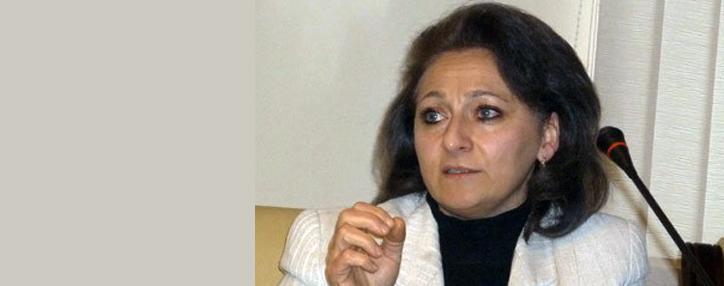Danger of HIV underestimated in Armenia
08.11.2013,
11:14
Human immunodeficiency virus (HIV) that causes acquired immunodeficiency syndrome (AIDS) is one of the global public healthcare’s gravest problems – it has taken more than 25 million lives for three decades.

Human immunodeficiency virus (HIV) that causes acquired immunodeficiency syndrome (AIDS) is one of the global public healthcare’s gravest problems – it has taken more than 25 million lives for three decades.
In 2012, there were 35.3 million people with HIV across the world. Of them, 25 million lived in Africa.
In the Eastern Europe and the Central Asia, including Armenia and other former Soviet republics, the number of HIV positive people has reached 1.3 million. Zhaneta Petrosyan, head of the health ministry-affiliated National AIDS Prevention Center’s division in charge of prophylaxis, has described the situation in Armenia in an interview with ARKA News Agency.
ARKA – What аrе the latest figures in the world and in Armenia?
Petrosyan – Some 2.3 million HIV-infected people were revealed in the world in 2012. Of them, 130,000 in the South Caucasus – four times more than the number of new cases in the West and Central Europe and about three times more than the Northern America’s figure. Some 260,000 children were infected in 2012. Some 1.6 million people died of AIDS in 2012. Of these people, 91,000 were from South Caucasus.
Registration of HIV-infected people began in Armenia in 1988.
In late September 2013, there were 1,541 HIV positive people in Armenia. The greatest number, 228, was recorded in 2012. Some 789, including 202 women and 15 children, were diagnosed with AIDS.
Some 344 people have died since 1988, when first HIV case was recorded. Of them, 58 were women and seven children.
Of the registered HIV positive people, 1066 (70%) are males, 454 (30%) are females and 28 (1.8%) are children.
About 56% of HIV-infected people were at the age between 25 and 39 at the moment of diagnosis.
There are HIV positive people in all the provinces of Armenia. The largest number of HIV cases is recorded among Yerevan residents – 578 (38%). Shirak province is the second largest HIV-affected province in Armenia – 11%.
Experts say the potential number of people living with HIV may be 3,500 in Armenia.
The number of HIV-infected and AIDS-diagnosed people has grown over recent years due to enhancement of availability of laboratory tests and medical workers’ awareness of HIV/AIDS and thanks to the classes conducted by the National AIDS Prevention Center for them. Medical workers now more frequently send their patients to the laboratories for HIV blood testing.
As a result, HIV testing and revelation have become more frequent.
The increase of the number of registered HIV positive people has also resulted from the growing number of our citizens returning to Armenia from CIS countries with clinical signs and already diagnosed HIV.
More than 50% of people diagnosed with HIV in recent four years have probably been infected abroad, mostly in Russia and Ukraine. Some 61.8% of the people diagnosed with HIV in 2012 alone have been infected outside of Armenia, and 20% are their partners. It means the migration factor is seen in 80% cases.
ARKA – What are signs of HIV infection? When should one request medical assistance? What are the most likely ways of HIV transmission?
Petrosyan – This virus is transmitted only by some biological substances, such as blood, sperm, vaginal secretion and breast milk. These substances of HIV positive people infect healthy people through mucous membranes or damaged skin.
It means one can catch the virus via sexual contacts and injection of drugs as well as through donor blood.
An HIV-infected woman transmits the virus to her baby while pregnant, while giving birth to her baby and while feeding.
People can’t transmit the virus by touching each other and using common ware or toilet facilities.
The virus is not transmitted via meals. It means communication with HIV positive people is absolutely harmless. Mosquito bites are harmless as well.
Heterosexual contacts (58%) and injections by drug addicts (32%) are main ways of HIV transmission.
There are, however, cases of HIV transmission via homosexual contacts, from mother to baby and through blood.
Infected people have no outward signs of the virus, and therefore their appearance doesn’t differ from other people appearance.
This disease is sneaky for its long latent period (eight to ten years), during which HIV positives feel as usually and don’t think they are infected, but they may infect others.
To find out the virus, if any, at early stages it is necessary to undergo HIV blood test in three months after probable infection contamination, when blood already contains sufficient numbers of antibodies.
Early diagnosis makes it possible not only to start appropriate treatment, which is very important for long maintenance of well-being, but it also gives people a chance to make reasonable decisions on how to live avoiding transmission of the virus to other people.
A pregnant woman who knows she is HIV positive can lessen risk of infection of her unborn baby.
ARKA – The World Health Organization’s figures show that more than two third of HIV infection cases are recorded in Africa. However, in recent years the virus affected also European and Asian countries. Is Armenia among high-risk countries?
Petrosyan – In Armenia 0.2% of adult people aged from 15 to 49 are HIV positive, while in the East Europe and the Central Asia region, in which Armenia is included, this rate is recorded at 0.7%, and in the world rate at 0.8%.
ARKA – The number of HIV-infected people receiving antiretroviral therapy in Armenia rose 2.5 times in 2012, compared with 2009, to 449. Why has it happened?
Petrosyan – Now all those people needing antiretroviral treatment and giving their consent receive it.
The number of people who receive treatment has grown because the figure of registered cases has grown.
The list of people receiving antiretroviral treatment includes also patients subject to treatment, but who have been diagnosed earlier.
The increase of the number of people under antiretroviral treatment is also due to the change made in treatment start criteria in compliance with the World Health Organization’s recommendations.
ARKA – Does the government subsidize treatment of HIV-infected people?
Petrosyan – Treatment of such patients is free. Medicaments and test systems for laboratory testing are provided under a program financed by the Global Fund to Fight AIDS, Tuberculosis and Malaria.
ARKA – Is there proper public awareness of this disease danger in Armenia?
Petrosyan – People in Armenia are ill-informed about HIV prevention, and this is one of HIV-spreading factors. That is why it is very important to enhance public awareness by organizing appropriate events.
Epidemiologic peculiarities of infection in the country as well as social factors and behavior which drive HIV rate up should be taken into account in organizing such events.
On the other hand, even well-informed persons are using their knowledge not always, maybe because they think HIV danger so unrealistic and so far from them and maybe because they think they can’t catch this virus.
Many organizations take special measures enhancing awareness of HIV/AIDS and giving safe behavior knowledge to the population, especially young people and migrants with their family members.
Special programs and social footages are aired. Articles are posted in electronic media outlets and printed in newspapers.
The most vulnerable categories are drug addicts, commercial sex workers and homosexual men.
Young people awareness of HIV/AIDS is insufficient so far.
In 2011, an HIV/AIDS issues were included in the Healthy Lifestyle course for school students.
ARKA- How HIV is diagnosed and how much the diagnostics is cost?
Petrosyan – The National AIDS Prevention Center Final makes diagnostics for free. Pre- and post-test advice is provided to all the visitors of the centre. Privacy is guaranteed. To be tested, one needs to visit the National AIDS Prevention Center. Address: Avan, Acharyan Street, 2, Yerevan.
Hot line 61-08-20 is available every day but weekends from 09:00 to 18:00. ---0----



